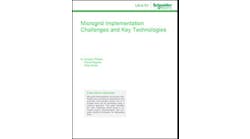The influx of renewables is driving a new use case for supervisory control and data acquisition (SCADA) systems, according to Brett Benson, marketing director for global renewable energy solutions at global automation technology and software firm Emerson.
Benson recently sat down with Microgrid Knowledge’s managing editor Rod Walton to discuss the intersection of SCADA and power generation.
SCADA, which the energy industry has traditionally relied on for real-time monitoring and control of transmission distribution systems, is not typically associated with power generation. But that’s changing with the increased penetration of renewable energy resources in the grid, according to Benson.
Utilities may have dozens of renewable assets, including wind, solar, battery or hydro, scattered at largely unmanned sites across the country, Benson explained.
“Renewable energy really lends itself well to SCADA,” because it is well-suited for performance monitoring, Benson said. “There are a lot of different calculations within the wind and solar that will give us … KPI [key performance indicator] type data and help us understand how well our assets are performing and if there is a problem,” he added.
Benson and Walton discussed how SCADA can help leverage the vast quantities of data generated by renewable sites to improve the reliability and lifespan of power assets.
Solar sites generate between 200 and 500 data points per megawatt (MW). Compare this to a traditional combined cycle plant, which typically generates 25 data points per MW, according to Benson.
“Battery storage actually can be as high as 1,500 points per megawatt,” Benson said. That means “a 750-MW battery site may have a million points of data [and] there is no way that a human person can analyze a million points of data.”
SCADA systems can be utilized to collect the millions of data points for analysis and interpolation by artificial intelligence-powered analytics tools. These tools can mine the information to detect issues and empower informed decisions around things like when to send a technician to make a repair –– and which parts need to go on the truck.
Benson also outlined his vision of the future, driven by the intersection of SCADA and power generation.
“What I really believe can happen with the advent of all these technologies is better dispatching of our assets, particularly with renewables,” Benson said. “When I couple solar photovoltaics and battery storage together, now I have a dispatchable plant. And if I put some intelligence behind that, maybe I can automate that dispatch in such a way that it becomes the world's first fully autonomous power plant.”








